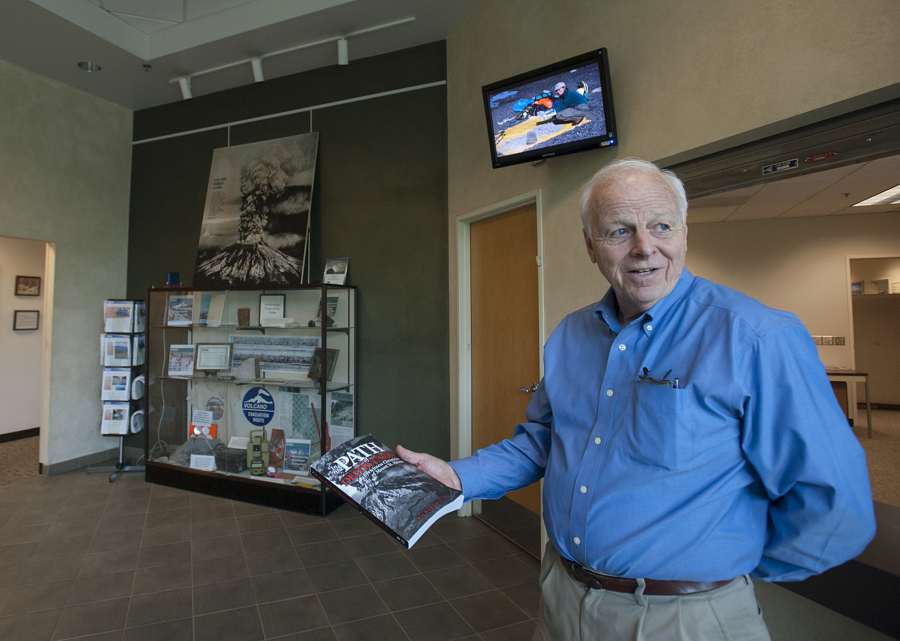Fifty-seven people perished when Mount St. Helens erupted, and even more feared that death was closing in.
• A geologist in an airplane that was red-lining at 220 mph screamed to the pilot: “Go faster!”
• A woman snapping photos out the back window of a Jeep that was taking corners on two wheels cried: “We’re gonna die!”
• A passenger in an Oldsmobile with a stalled engine wondered: “God … are we going to die because the car won’t start?”
Did You Know?
• Before the publisher made the final decision on the title, Richard Waitt was calling his book “Dark Noon.”
• A man took cover under a log with his two boys, and one asked: “Daddy, are we going to live with Jesus?”
His father replied, “Well … maybe, but not now.”
They all survived. They also witnessed a historic event, and are among hundreds who shared their memories of May 18, 1980, with Richard Waitt. The U.S. Geological Survey scientist is the author of “In the Path of Destruction: Eyewitness Chronicles of Mount St. Helens.”
“It began as a few eyewitness accounts to aid geological research,” the Vancouver geologist said. “The original purpose was science.”
If he didn’t seek out the survivors, he said, “I’d never know what some of these people found by almost getting caught in the eruption.”
Waitt knew that if their accounts were accurate, he would get information about volcano behavior that he never could discover as a geologist in the field.
Science and adventure
After hearing his first survivor story in a bar shortly after the eruption, Waitt learned that each interview was going to be a two-for-one event. The second part of the interview?
“They wanted to tell their adventure story,” Waitt said. “Fortunately, I realized that I should be writing it down” along with all the scientific data.
Waitt spent almost 35 years gathering material for the book, which was published in January 2015. He interviewed about 400 people, including survivors, fellow scientists, law officers, state and federal officials, campers, loggers, local residents, journalists, pilots and military rescue personnel.
The first interview in June 1980 was sparked by a Seattle Post-Intelligencer newspaper story about two people who outran the pyroclastic flow. Waitt contacted them through the reporter and set up an interview in a Seattle bar.
“A terrible place for an interview,” he noted.
Gil Baker was a photographer; Kathie Baker (not related) was a writer who went along to write captions for Gil’s volcano photos. She was the one who wondered if they were going to die because his Olds Toronado was stalled.
Waitt wanted details.
She described the leading edge of the black ash cloud as an inky waterfall. As they fled doing 105 mph along straight stretches of road, she didn’t say anything to Baker about the incredible sight. She was afraid he’d stop for a photograph.
Waitt also got scientific data as she described what they had driven through.
“It was pounding down with great authority. I wouldn’t have known that from a site visit,” Waitt said.
“As time permitted, I’d do an interview and write it up.”
Waitt, 73, was still gathering information decades after the eruption. The most recent interviews in his witness log took place in 2014.
“There are a lot of reasons it took 35 years,” Waitt said at his Cascades Volcano Observatory office in east Vancouver. “It’s a part-time job. I had dabbled with it on my own time.”
The process speeded up when a couple of USGS officials became interested in what Waitt was discovering.
His job did provide a big advantage in credibility.
“If I call from a USGS building, people take me seriously. From home, not so much,” said Waitt, who did a book reading in March at Vintage Books in Vancouver.
His USGS position also gave Waitt access to people and records at state and federal agencies.
His job helped
As a scientist, Waitt shows up in his book as a researcher. Visiting ruined vehicles or pieces of logging equipment, he could gauge the temperature of the surge that swept over them by seeing how the heat affected paint, glass and plastic components.
He read the path of the surge through the patterns of downed trees as Waitt flew over what he calls 234 square miles of devastation.
That turns out to be an interesting choice of words.
“We don’t use the words ‘devastation’ and ‘destruction’ in geology. Volcanoes build landscapes.”
The stories Waitt heard from people who saw Mount St. Helens up close could certainly widen a person’s perspective, particularly stories from people who thought they were going to die.
“The survivors inside the surge are speaking for tens of thousands of others,” whether they survived or perished in volcanic eruptions over the centuries. “They all go through the same experiences, live or die. Their stories have never been told, and this is a unique book in that way.”




